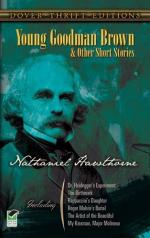|
This section contains 1,247 words (approx. 5 pages at 300 words per page) |

|
The Allegorical Nature of "Young Goodman Brown"
Summary: This essay examines the many allegorical aspects of the short story "Young Goodman Brown" written by Nathaniel Hawthorne.
Nathaniel Hawthorne is eminent for his works that portray the iniquitous evilness dwelling behind the images of rectitude embedded into Puritan society during the 17th century. Hawthorne's depiction of hidden wickedness is emphasized in âYoung Goodman Brown,â a short story published in 1835, about a naïve Christian man who sets out on a mysterious journey only to come to the discernment that everyone he knows has sinned in one way or another, causing him to cynically question the righteousness of the people whom he has always thought as decently good people. The allegorical nature of Hawthorne âs work is evident in his combination of diction, symbolic objects, and details to ultimately expose the true weakness rooted in mankind for eternity.
Hawthorne uses diction to justify the meaning hidden behind each character and the characterâs name, relevant to the juxtaposition of good and evil entwined into humans. The...
|
This section contains 1,247 words (approx. 5 pages at 300 words per page) |

|


